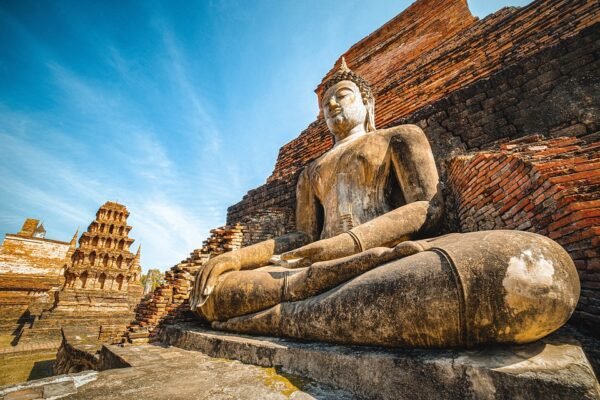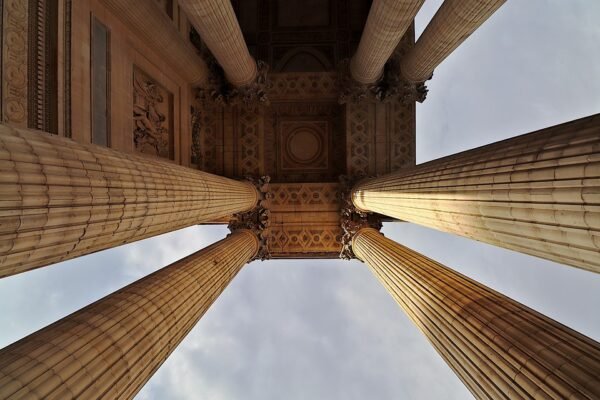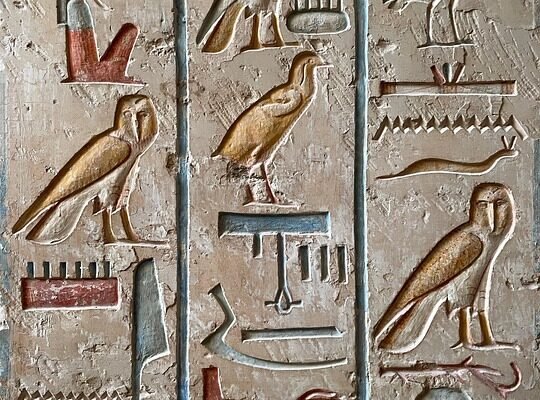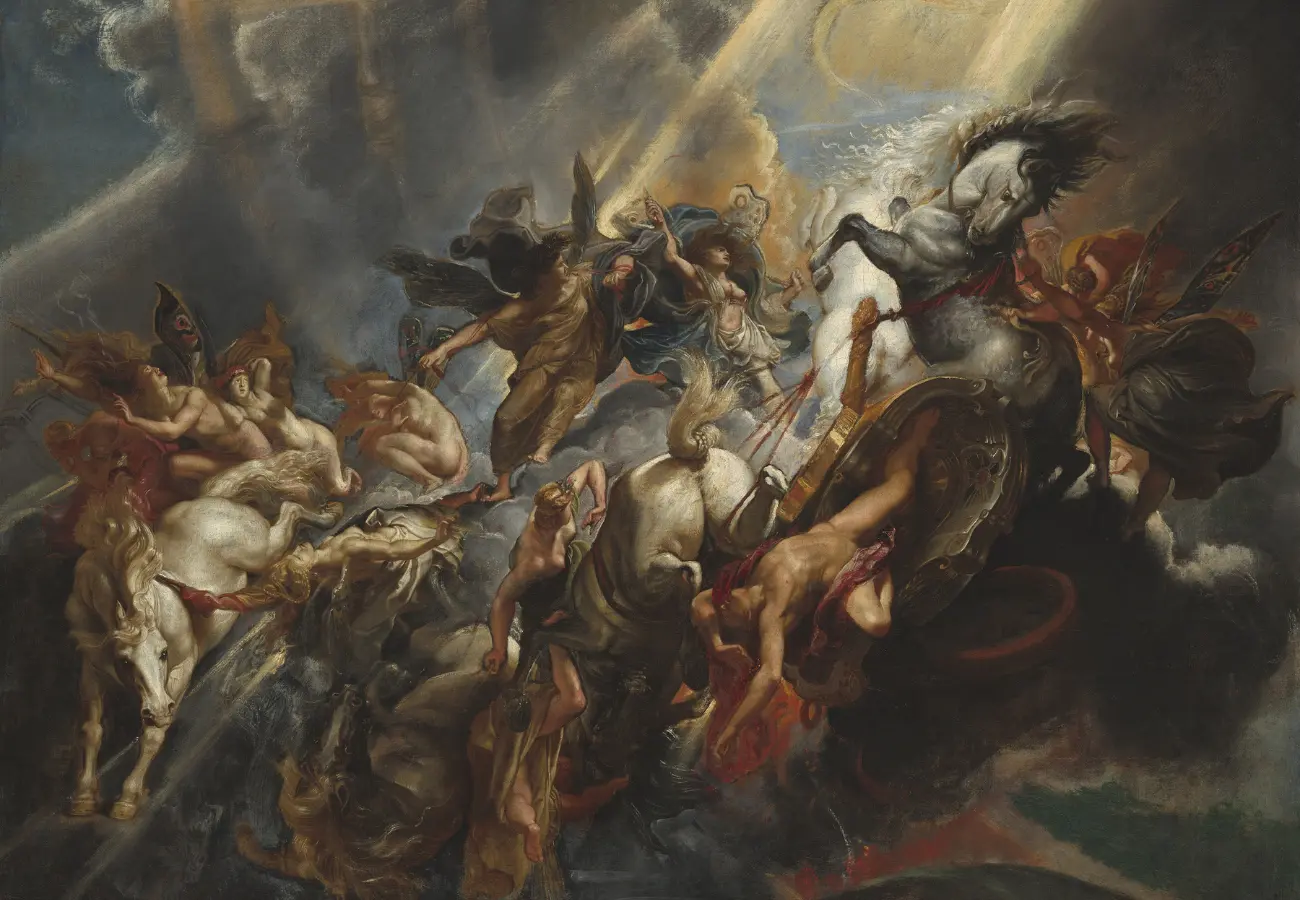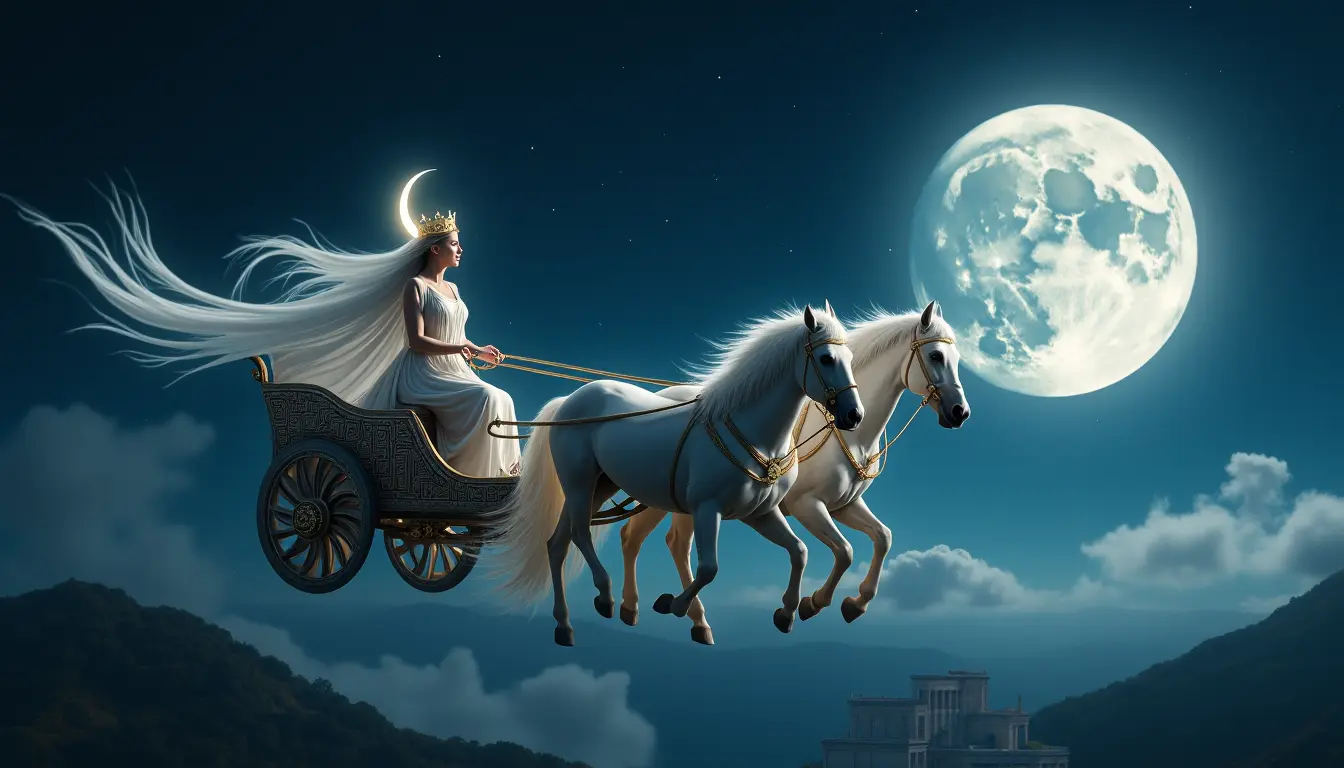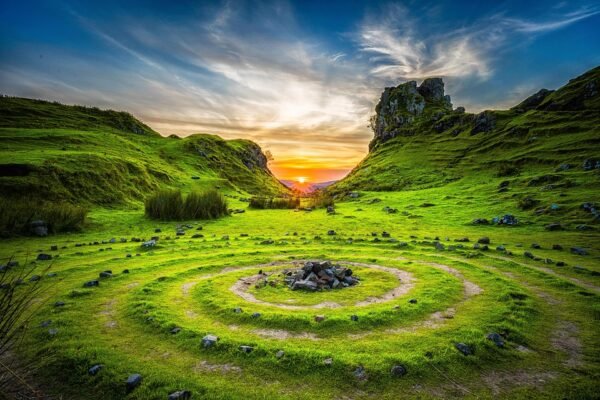
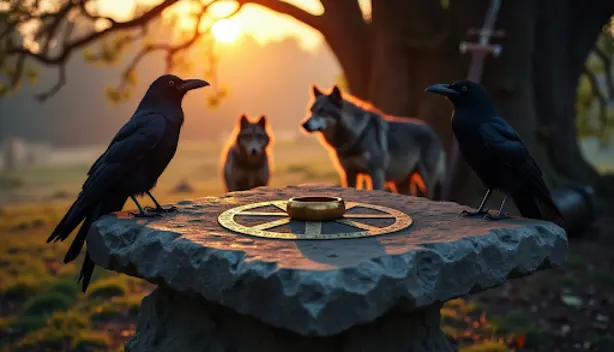
The Hidden Symbols of the God Odin: Ancient Norse Secrets
The symbols of the God Odin always fascinate me, as each symbol holds deep meaning in Norse mythology. The Allfather’s symbols tell amazing stories – from Gungnir, his spear that never misses its mark, to Draupnir, the magical ring that creates eight copies of itself every ninth night.
Odin’s loyal ravens, Huginn and Muninn, represent thought and memory and act as his eyes throughout the Nine Worlds. His eight-legged horse Sleipnir takes him between different realms, while his wolves Geri and Freki stand guard as powerful symbols of his warrior spirit.
The Valknut, with its three interwoven triangles, shows Odin’s command over life and death. His wisdom-seeking nature shines through the Triple Horn, a symbol tied to the legendary Mead of Poetry. The Ansuz rune speaks of his gift for divine messages and inspiration.
These symbols of the God Odin appear everywhere – from ancient Norse artifacts and literature to modern interpretations. They paint a vivid picture of Odin’s character that reaches way beyond the reach and influence of ancient times. Every symbol reveals something unique about him, from his endless quest for knowledge to his roles as both warrior god and fate’s master.
Table of Contents
This comprehensive guide explores Odin’s sacred symbols and their meanings:
The Significance of Odin in Norse Mythology
Understanding Odin: The Allfather in Viking Culture
The Multifaceted Role of Odin
Odin as a Symbol of Authority and Wisdom
Odin in Myths and Sagas
Odin’s Cultural Effect
Sacred Symbols and Their Meanings
Draupnir: Odin’s Ring of Endless Bounty
The Valknut: Odin’s Knot of the Slain
Odin’s Ravens: Huginn and Muninn
Gungnir: Odin’s Spear
The Triple Horn of Odin
Wolves of Odin: Geri and Freki
Sleipnir: The Eight-Legged Horse
Wisdom and Legacy
Odin’s Mythology
Odin’s Wisdom and Knowledge
Odin’s Spiritual Messages
Odin’s Connection to Warriors
Odin’s Role as a Wanderer
Odin’s Presence in Modern Culture
Runes and Their Powers: The Ansuz Rune
Each section reveals the rich symbolism and deep meanings behind these Norse symbols and their connection to the Allfather Odin. These ancient symbols of the God Odin continue to strike a chord with people who seek spiritual guidance and wisdom.
The Significance of Odin in Norse Mythology:
Odin reigns as the supreme deity in Norse mythology. People know him as the Allfather and ruler of Asgard. His power touches everything from wisdom and poetry to death, divination, and magic. This makes him one of Norse mythology’s most fascinating figures.
His endless quest for knowledge defines Odin’s importance. He gave up one of his eyes at Mímir’s well to gain wisdom. This sacrifice shows his deep commitment to understanding the cosmos and explains why he became central to Norse religious practices.
Magic and sorcery set this god apart from other deities. He mastered seiðr, a form of Norse magic that gave him power over fate and destiny. All the same, his influence goes beyond magical powers – he watches over rulers, warriors, and poets alike.
Odin’s character as a wanderer and seeker of wisdom makes him unique. His never-ending search for knowledge shaped him into both a wise ruler and a cunning trickster. He gathered wisdom through his experiences across the Nine Worlds that made him Norse mythology’s most respected figure.
His impact spreads through every aspect of Norse culture, from kingship to warfare. Kings claimed him in their family trees, and warriors dedicated their victories to his name. Odin’s complex character continues to captivate scholars and enthusiasts. He remains a powerful symbol of wisdom and strength in Norse mythology. The cosmos of Norse mythology was populated by various beings, including the mighty Norse giant names who often challenged Odin’s authority.
Understanding Odin: The Allfather in Viking Culture
Norse god Odin shaped Viking society profoundly. His influence reached way beyond religious worship, especially in the Vikings’ understanding of leadership and social structure. Beyond his own sacred animals, Odin’s influence extended to many Viking mythical animals that played crucial roles in Norse mythology.
The Multifaceted Role of Odin
The chief of Æsir gods, Odin took on many roles at once. He ruled over warfare, poetry, death, and wisdom instead of focusing on a single domain. His quest for knowledge through personal sacrifice, especially at Mímir’s well, strongly appealed to Viking values that celebrated self-improvement through challenges.
Odin as a Symbol of Authority and Wisdom
The Allfather’s connection to kingship ran deep in Viking society. Kings strengthened their rule by claiming Odin as their ancestor. His mastery of runes and prophecy also made him the patron deity of poets, scholars, and knowledge seekers.
Odin in Myths and Sagas
Norse literature portrays Odin in different forms – a wanderer in a blue cloak or a wise counselor. His adventures with his eight-legged horse Sleipnir show how he connected different worlds and realms of existence.
The Cultural Impact of Odin
Odin’s influence spread through every aspect of Viking life, from warfare to poetry. Warriors asked for his blessing before battle, and skalds considered him their guardian deity. His dedication to gaining wisdom through sacrifice became the Vikings’ model for personal growth and spiritual development.
Sacred Symbols and Their Meanings
Draupnir: Odin’s Ring of Endless Bounty
Draupnir, Odin’s magical ring, remains one of the most powerful symbols in Norse mythology. The skilled dwarven brothers Brokkr and Eitri crafted this remarkable artifact that represents abundance and infinite wealth in Norse tradition.
Creation and Origin of Draupnir
A remarkable contest of craftsmanship brought this ring into existence. The dwarf brothers forged this masterpiece among other legendary items, including Thor’s hammer Mjolnir and Freyr’s ship Skidbladnir. Their exceptional skill and magical prowess resulted in a ring that stood apart from all others.
Magical Properties of Draupnir
Draupnir’s most remarkable feature lies in its self-multiplying nature. Eight new rings of equal weight and quality drip from the original every ninth night. This characteristic gave the ring its name “Draupnir,” which means “the dripper” in Old Norse. The ring symbolizes:
Wealth generation
Abundance
Renewal
Multiplication
Mythological Significance of Draupnir
Symbol of Wealth and Prosperity
The ring embodies Odin’s role as a provider and his influence over wealth distribution. Its self-replicating nature reflects the concept of abundance in Norse culture.
Draupnir at Baldur’s Funeral
The ring played a vital role at Baldur’s funeral when Odin placed it on his son’s funeral pyre. This gesture showed both his grief and the ring’s importance as a symbol of eternal cycles.
Draupnir’s Role Across Myths
The ring appears in Norse tales of all types and serves as a symbol of oaths and promises between gods and mortals.
Symbolism of Draupnir
Draupnir represents more than its physical properties in Norse mythology. The ring’s power to create new versions of itself mirrors the Norse understanding of regeneration and the eternal cycle of life and death.
The Valknut: Odin’s Knot of the Slain
The Valknut stands as one of Odin’s most sacred symbols, featuring three interlocked triangles in an enigmatic design. Ancient Scandinavian archaeological finds, from runestones to burial sites, showcase this remarkable Norse symbol.
What is the Valknut?
Learning about the Valknut’s Design
The word “Valknut” comes from two Old Norse words: “valr” (slain warriors) and “knut” (knot). Three triangles interweave in an intricate pattern that makes up this symbol. Each triangle shows a different aspect of Odin’s command over life, death, and destiny.
Variations of the Valknut Design
The Tricursal Valknut
The symbol most often appears with three distinct triangles, their corners and lines creating nine points. This design highlights the sacred number nine in Norse mythology that mirrors Yggdrasil’s nine worlds.
The Unicursal Valknut
A rarer version draws the symbol with a single continuous line. This design represents how everything under Odin’s influence connects together.
Valknut in Viking Burials
Archaeologists have found the Valknut on warrior burial goods. These findings suggest it marked those Odin chose for Valhalla. The Stora Hammars I stone from Gotland displays this symbol next to scenes of battle and sacrifice.
Cultural and Religious Significance
The Valknut holds several symbolic meanings:
Represents Odin’s power to bind and unbind
Marks sacred spaces and ritual grounds
Symbolizes the connection between life, death, and rebirth
Acts as a protective symbol for warriors
Scholars and practitioners of Norse traditions still find this powerful symbol captivating today. It reminds us of Odin’s complex nature as both a god of wisdom and warfare.
Odin’s Ravens: Huginn and Muninn
Two magnificent ravens rest on Odin’s shoulders as his most trusted companions and scouts. These ravens, Huginn and Muninn, embody thought and memory that extend Odin’s consciousness throughout the Nine Worlds. Just as Valkyries names carried deep meaning, Huginn and Muninn’s names reflected their crucial roles in Odin’s divine mission.
The Ravens in Norse Mythology
These wise creatures, Huginn (“thought”) and Muninn (“memory”), are black as the darkest night. They soar across the world each day to gather news for their master. Every evening, they return to Odin’s shoulders and whisper their findings directly into his ears. This keeps him informed about everything happening in the world.
Symbolic Representation and Mythological Importance
The ravens represent Odin’s endless search for knowledge and understanding. Their names reflect two basic aspects of consciousness – active thinking and stored memories. Daily flights of these birds show how we must actively seek wisdom and preserve it carefully.
Roles in Norse Myths
The ravens serve several vital functions:
They scout the Nine Worlds for Odin
They represent the duality of mental processes
They stand as symbols of divine wisdom
They keep cosmic awareness through their observations
Symbolizing Odin’s Powers
Huginn and Muninn show Odin’s command over knowledge and his power to see events beyond normal sight. These faithful messengers help him stay aware of everything that happens. Norse art often shows these ravens as inseparable from Odin, which highlights their importance as extensions of his divine awareness.
Gungnir: Odin’s Spear
Skilled dwarven smiths crafted Gungnir, which stands as the greatest weapon ever made in Norse mythology. Sacred runes adorn this legendary spear that became Odin’s most trusted companion through countless battles and adventures. The influence of sacred weapons like Gungnir continues today, as shown in how Viking weapons can be seen in the modern world.
The Legend of Gungnir
Norse mythology changed forever at the time Gungnir came into existence. The sons of Ivaldi, who were master craftsmen among dwarves, created this magnificent spear with their exceptional skills. Their craftsmanship gave Gungnir extraordinary powers – the spear strikes its target with perfect accuracy, whatever the wielder’s skill or battlefield conditions might be.
Symbolic Meanings of the Spear
Emblem of Divine Authority
This weapon symbolizes Odin’s supreme power over Oods and mortals alike. Gungnir’s presence makes oaths and ceremonies significant as it represents divine law and order. Odin uses this spear to enforce his will and keep the cosmic balance throughout Norse mythology.
Representation in Warfare
Gungnir embodies everything in battle:
Perfect accuracy to curb enemies
Authority over life and death
Sacred oaths and binding contracts
Divine judgment and intervention
The spear’s power reaches way beyond the reach and influence of the battlefield, though its main goal remains connected to warfare and leadership. Any army that Odin throws Gungnir over becomes dedicated to him. This dedication marks them either for victory or a warrior’s death. The weapon brings both blessings and curses, which mirrors Odin’s complex nature as a deity of wisdom and war.
The Triple Horn of Odin: Symbol of Wisdom and Might
Ancient Norse artifacts show the Triple Horn of Odin as a powerful symbol with three interlocked drinking horns. This mystical emblem has deep roots in Norse mythology and continues to appeal to modern practitioners of Norse traditions.
What is the Triple Horn?
Three drinking horns arranged in a triangular pattern make up the Triple Horn, and each horn intertwines with the others. The design represents the three draughts of the Mead of Poetry that Odin drank, which marked his command over poetic inspiration and creative wisdom.
Cultural and Symbolic Significance
The Triple Horn holds profound meaning in Norse culture without doubt, and it represents both physical and spiritual sustenance. This sacred symbol appears on runestones, jewelry, and ceremonial objects that signify the connection between mortals and wisdom from above.
Connection to the Mead of Poetry
The legend of Odin’s quest for the Mead of Poetry ties to the Triple Horn’s symbolism:
Knowing how to tap into divine inspiration and poetry
Sacred knowledge and spiritual enlightenment
Growth through wisdom
Links to ancestral traditions
Symbol of Creative and Intellectual Pursuits
The Triple Horn’s connection to the Mead of Poetry represents the path to higher understanding. Odin’s eternal quest for knowledge serves as inspiration to those who seek wisdom. The three horns mirror Norse mythology’s three wells of wisdom, which highlight learning, memory, and inspiration’s importance in the interests of understanding.
Wolves of Odin: Geri and Freki
Two magnificent wolves, Geri (“the greedy”) and Freki (“the ravenous”), stand among Odin’s ravens as faithful guardians of the Allfather’s high seat in Valhalla. These fierce companions are more than pets – they embody Odin’s warrior nature.
The Companions of Odin
Geri and Freki rest at Odin’s feet during Valhalla’s feasts and receive his food while he drinks only mead. Their constant presence at his side shows the perfect balance between wisdom and raw power that defines the Allfather’s essence.
Symbolism of Strength and Loyalty
The wolves represent steadfast dedication and fierce protection. Their names reflect their voracious nature and symbolize the warrior spirit that Odin values. Their presence substantially reinforces Odin’s connection to both wild and civilized realms of existence.
Embodiments of Warrior Attributes
These sacred wolves represent warrior qualities:
Courage in battle
Fierce loyalty to their leader
Victory’s relentless pursuit
Unity of strength and strategy
Symbols of Divine Protection and Guidance
Geri and Freki’s vigilant watch in Valhalla protects divine wisdom. Their presence teaches warriors that strength needs loyalty’s temperance, and wisdom must guide power – core principles in Odin’s teachings.
Sleipnir: The Eight-Legged Horse of Odin
Sleipnir stands as the most remarkable steed in Norse mythology. This magnificent horse gallops through the cosmos on eight powerful legs and serves as Odin’s trusted companion between realms. The extraordinary horse came from Loki’s shape-shifting powers and moves with matchless speed and agility.
Sleipnir in Norse Mythology
The eight-legged horse emerged from an unusual union. Loki transformed into a mare and mated with the stallion Svaðilfari. Sleipnir’s eight legs represent the cardinal and intercardinal directions, showing complete cosmic coverage. He can guide himself through any terrain, from towering mountains to Niflheim’s depths.
Symbol of Exceptional Mobility
Sleipnir combines raw strength with supernatural powers. His storm cloud-gray coat marks him as a creature of both earthly and mystical origins. Speed and power flow through his very being.
Bridging Realms and Worlds
Odin’s trusted mount crosses the boundaries of the Nine Worlds with ease. He guides himself through Yggdrasil’s branches and connects different realms of existence.
Odin’s Mobility and Mastery Over the Cosmos
Sleipnir helps Odin show his power over all realms. The horse’s otherworldly abilities mirror Odin’s command over space and time. This lets the Allfather perform his sacred duties. Their bond represents the perfect blend of divine purpose and cosmic strength that keeps order in the Nine Worlds.
Odin’s Mythology
Norse mythology tells us about an array of tales that showcase Odin’s extraordinary life. The story starts when he created the world with his brothers Vili and Vé, marking existence’s beginning.
Odin’s relentless search for knowledge drove him to make incredible sacrifices. He hung himself from Yggdrasil, the world tree, for nine days and nights to learn the wisdom of the runes. This ordeal gave him deep understanding about existence itself.
The ancient stories describe his daily visits to Mímir’s well, showing his endless pursuit of wisdom. He gave up his eye to drink from these waters of knowledge – proof of his commitment to understanding the cosmos.
The sort of thing I love comes from stories about his encounters with mortals. Odin would disguise himself to test people’s hospitality and wisdom. These tales show him as both a wise teacher and strict judge who shaped Norse society’s moral values.
His story connects with prophecies of Ragnarök, where he commands the Einherjar against chaos. Despite knowing Fenrir would defeat him in this cosmic battle, Odin kept gathering knowledge to prepare for this final confrontation.
Odin’s mythology does more than tell stories – it helps us understand Viking culture’s views on wisdom, sacrifice, and destiny. While many associate Vikings with warfare, their culture had a sweeter side too. Just as what kind of candy did Vikings eat shows us their daily pleasures, Odin’s mythology reveals their spiritual depths.
Odin’s Wisdom and Knowledge
Wisdom’s quest serves as the life-blood of Odin’s nature. His ways of gaining knowledge involved extreme sacrifices, which made him the greatest seeker of understanding in Norse mythology.
Odin’s Role as the God of Runes
We mainly knew him for his command over runic wisdom, but Odin’s connection to knowledge goes deeper than just academic pursuit. His sacrifice on Yggdrasil – hanging for nine nights with wounds from his own spear – ended up leading to his discovery of the runes. This marked a crucial moment in Norse mystical tradition.
His grasp of seiðr magic, command of galdr (incantations), and deep knowledge of the runes highlight his all-encompassing approach to wisdom. Unlike other deities, Odin’s quest for knowledge reaches beyond physical boundaries into spiritual and magical realms.
His role as wisdom’s keeper reaches beyond just gathering knowledge. Odin maintains cosmic order through his understanding of the runes and uses this sacred knowledge to guide both gods’ and humans’ fate. This special position as both seeker and keeper of wisdom makes him unique in the Norse pantheon. He stands as the greatest source of mystical knowledge and understanding.
Odin’s Spiritual Messages
The Allfather’s sacred messages appeal across ages and speak to both ancient practitioners and modern followers of Norse traditions. These spiritual teachings show up in many forms – from dream messages to meaningful encounters with his sacred symbols.
Interpretations and Applications
Odin’s spiritual messages focus on personal growth and wisdom-seeking at their core. His teachings highlight self-sacrifice for greater understanding, similar to his own ordeal on Yggdrasil. Today’s practitioners interpret these messages through:
Natural Signs: Ravens appearing at key moments
Dream Wisdom: Symbolic encounters during sleep
Runic Messages: Patterns appearing in daily life
The spiritual essence of Odin’s teachings centers on transformation through challenge. His messages tend to appear during major life changes and guide followers toward personal growth and deeper wisdom.
Knowledge and intuition

